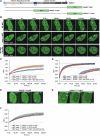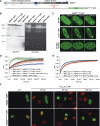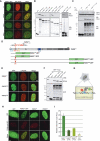PARG is recruited to DNA damage sites through poly(ADP-ribose)- and PCNA-dependent mechanisms
- PMID: 21398629
- PMCID: PMC3130271
- DOI: 10.1093/nar/gkr099
PARG is recruited to DNA damage sites through poly(ADP-ribose)- and PCNA-dependent mechanisms
Abstract
Post-translational poly(ADP-ribosyl)ation has diverse essential functions in the cellular response to DNA damage as it contributes to avid DNA damage detection and assembly of the cellular repair machinery but extensive modification eventually also induces cell death. While there are 17 human poly(ADP-ribose) polymerase (PARP) genes, there is only one poly(ADP-ribose) glycohydrolase (PARG) gene encoding several PARG isoforms located in different subcellular compartments. To investigate the recruitment of PARG isoforms to DNA repair sites we locally introduced DNA damage by laser microirradiation. All PARG isoforms were recruited to DNA damage sites except for a mitochondrial localized PARG fragment. Using PARP knock out cells and PARP inhibitors, we showed that PARG recruitment was only partially dependent on PARP-1 and PAR synthesis, indicating a second, PAR-independent recruitment mechanism. We found that PARG interacts with PCNA, mapped a PCNA binding site and showed that binding to PCNA contributes to PARG recruitment to DNA damage sites. This dual recruitment mode of the only nuclear PARG via the versatile loading platform PCNA and by a PAR dependent mechanism likely contributes to the dynamic regulation of this posttranslational modification and ensures the tight control of the switch between efficient DNA repair and cell death.
Figures





Similar articles
-
ADP-ribosylhydrolase 3 (ARH3), not poly(ADP-ribose) glycohydrolase (PARG) isoforms, is responsible for degradation of mitochondrial matrix-associated poly(ADP-ribose).J Biol Chem. 2012 May 11;287(20):16088-102. doi: 10.1074/jbc.M112.349183. Epub 2012 Mar 20. J Biol Chem. 2012. PMID: 22433848 Free PMC article.
-
Altered poly(ADP-ribose) metabolism impairs cellular responses to genotoxic stress in a hypomorphic mutant of poly(ADP-ribose) glycohydrolase.Exp Cell Res. 2007 Mar 10;313(5):984-96. doi: 10.1016/j.yexcr.2006.12.025. Epub 2007 Jan 10. Exp Cell Res. 2007. PMID: 17276427
-
The structure and catalytic mechanism of a poly(ADP-ribose) glycohydrolase.Nature. 2011 Sep 4;477(7366):616-20. doi: 10.1038/nature10404. Nature. 2011. PMID: 21892188 Free PMC article.
-
Roles of poly(ADP-ribose) glycohydrolase in DNA damage and apoptosis.Int Rev Cell Mol Biol. 2013;304:227-81. doi: 10.1016/B978-0-12-407696-9.00005-1. Int Rev Cell Mol Biol. 2013. PMID: 23809438 Review.
-
Poly(ADP-ribose): PARadigms and PARadoxes.Mol Aspects Med. 2013 Dec;34(6):1046-65. doi: 10.1016/j.mam.2012.12.010. Epub 2013 Jan 2. Mol Aspects Med. 2013. PMID: 23290998 Review.
Cited by
-
Site-specific analysis of the Asp- and Glu-ADP-ribosylated proteome by quantitative mass spectrometry.Methods Enzymol. 2019;626:301-321. doi: 10.1016/bs.mie.2019.06.024. Epub 2019 Jul 24. Methods Enzymol. 2019. PMID: 31606080 Free PMC article.
-
Multi-Level Control of the ATM/ATR-CHK1 Axis by the Transcription Factor E4F1 in Triple-Negative Breast Cancer.Int J Mol Sci. 2022 Aug 16;23(16):9217. doi: 10.3390/ijms23169217. Int J Mol Sci. 2022. PMID: 36012478 Free PMC article.
-
The impact of cyclin-dependent kinase 5 depletion on poly(ADP-ribose) polymerase activity and responses to radiation.Cell Mol Life Sci. 2012 Mar;69(6):951-62. doi: 10.1007/s00018-011-0811-6. Epub 2011 Sep 16. Cell Mol Life Sci. 2012. PMID: 21922195 Free PMC article.
-
Inflammation, necrosis, and the kinase RIP3 are key mediators of AAG-dependent alkylation-induced retinal degeneration.Sci Signal. 2019 Feb 12;12(568):eaau9216. doi: 10.1126/scisignal.aau9216. Sci Signal. 2019. PMID: 30755477 Free PMC article.
-
PARP-2 depletion results in lower radiation cell survival but cell line-specific differences in poly(ADP-ribose) levels.Cell Mol Life Sci. 2015 Apr;72(8):1585-97. doi: 10.1007/s00018-014-1765-2. Epub 2014 Oct 22. Cell Mol Life Sci. 2015. PMID: 25336152 Free PMC article.
References
Publication types
MeSH terms
Substances
LinkOut - more resources
Full Text Sources
Other Literature Sources
Molecular Biology Databases
Miscellaneous

